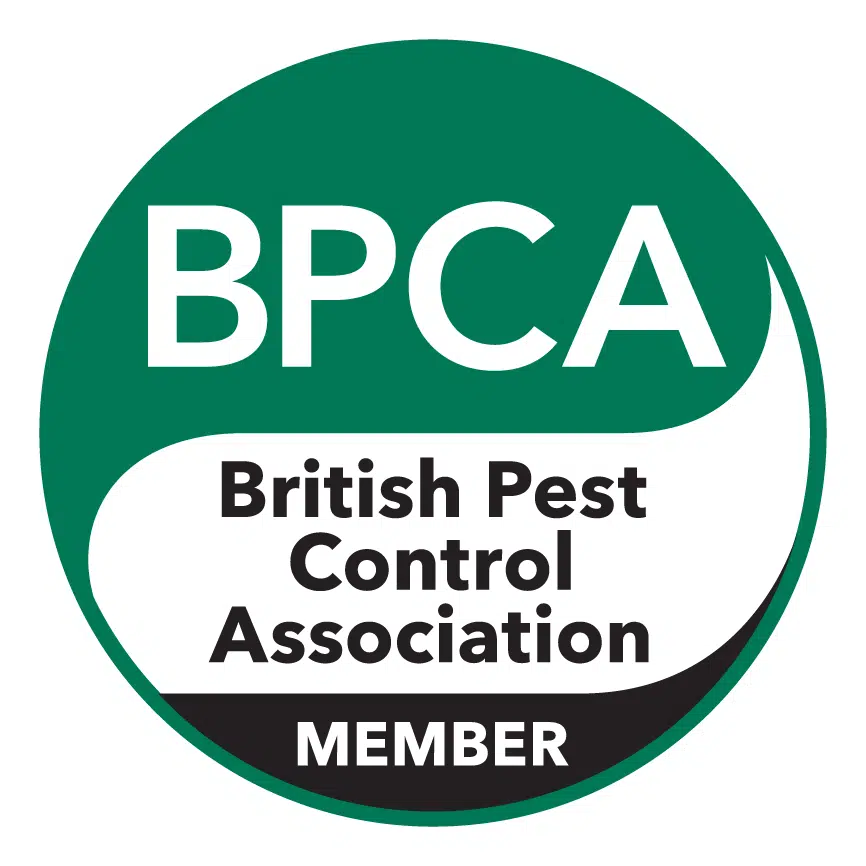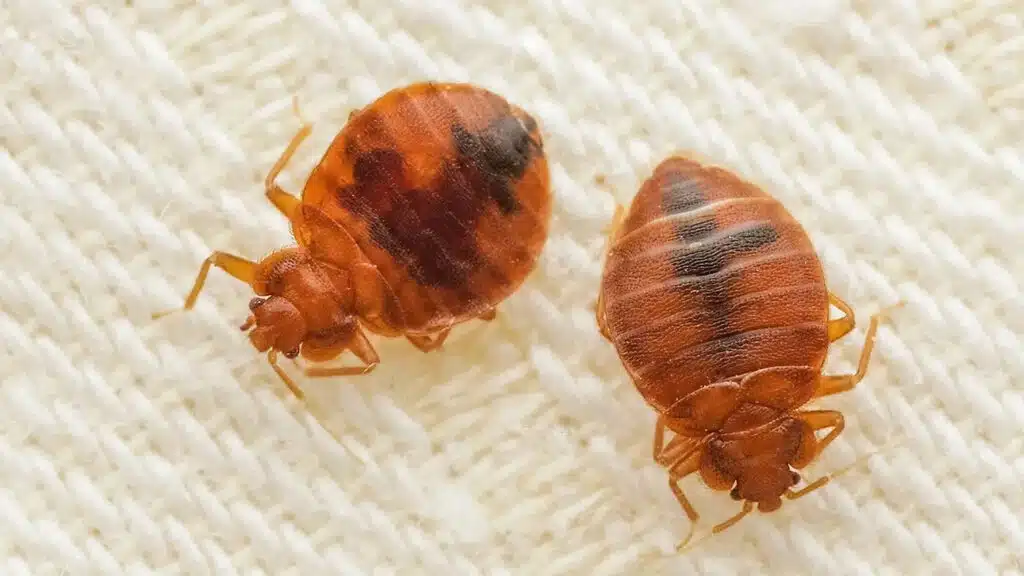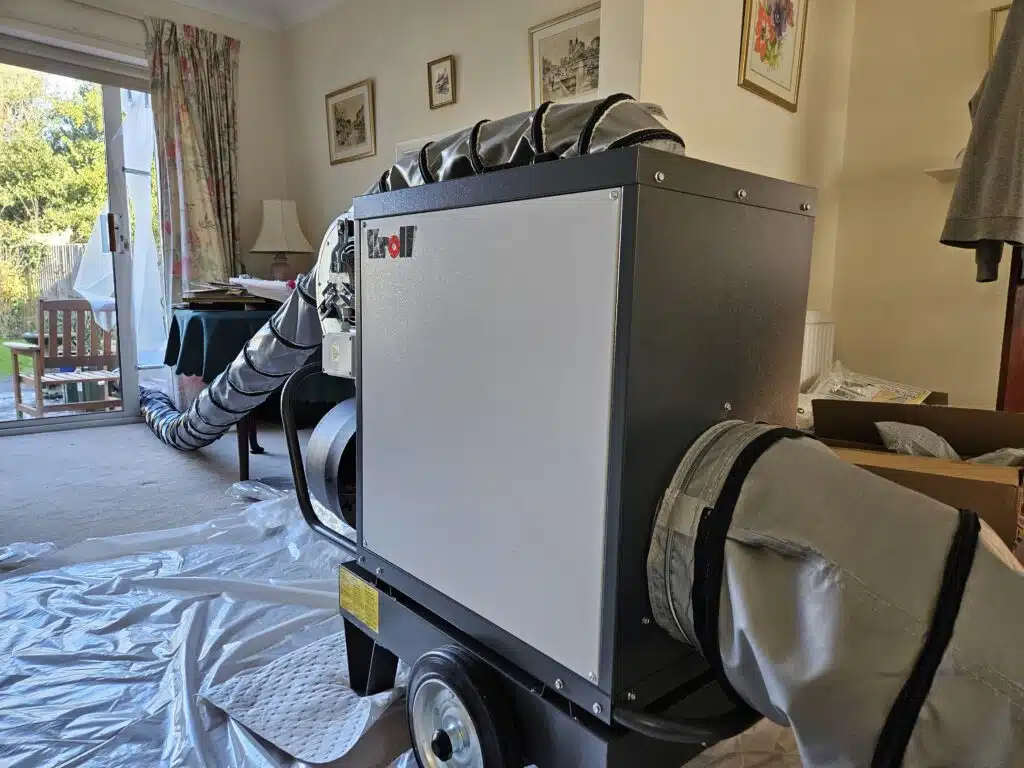Sustained heat above 49°C kills bed bugs and their eggs, reaching areas chemical sprays cannot.


Bed bugs keeping you up at night? You’re not alone.
These tiny pests can turn any home or business into a nightmare. Getting rid of bed bugs can be challenging, even for pest control professionals. Bed bugs hide in cracks and crevices that are hard to reach, from loose wallpaper and mattresses to light sockets and electrical outlets. To make exterminations even harder, these little pests are nocturnal insects, meaning they’re typically active at night.
When dealing with an infestation, it’s important to use the right treatment methods, whether that means non-chemical methods like heat treatment or professional extermination by a pest control company.
In order to pick the best extermination method, you need to make sure you actually have a bed bug problem. Here’s what to look for:
Bedbug bites leave small red welts, often in a line of clusters. These bites can be itchy and sometimes cause painful swelling. On black or brown skin, these bites can also appear purple and be harder to see. While these bites tend to be minor, some can transmit disease or infections. If you’re struggling with bug bites, put a damp cloth over the site. Other treatments might include antihistamines and mild steroids. (Learn more about what bed bug bites look like).
Bed bugs have either dark yellow or brown skin, which is shredded by adult bed bugs. Full-grown bed bugs are oval-shaped, are oval-shaped, reddish-brown insects that are wingless and flat. They’re small in size, around 1/4 to 3/8 inch long.
Bed bug eggs are tiny, oval-shaped, and pearly white, measuring about 1mm—roughly the size of a pinhead. They are often laid in clusters and tucked away in hiding places like loose wallpaper, behind picture frames, and even in electrics. The eggs have a sticky coating, helping them adhere to surfaces and making them difficult to remove.
Once the eggs hatch, they become nymphs, or young bed bugs, that are almost transparent until they start feeding on blood. As they grow, they shed their white skin shells multiple times before reaching adulthood. Spotting these eggs or shredded skin is a clear sign of an active infestation, meaning bed bugs are reproducing and spreading.
When on the hunt for these little pests, be sure to inspect inside bed frames, box springs, wall hangings, loose wallpaper, and small cracks. These unwanted guests are so tiny that you’ll probably need a magnifying glass and flashlight. Don’t forget: an infested room can also have infested items, like clothing, other furniture, and electrical outlets.
If you’re still not sure if you have a bed bug problem, try out a bed bug monitor. We also offer a free identification service for both homes and businesses.

Once you’ve confirmed you have bed bugs, it’s time to start extermination. Here are some at-home pest control methods to try at home: Be aware its almost impossible to kill all the bed bugs using home methods and it requires a professional treatment. Speak with our expert bed bug team today.
If you’re not a fan of chemical insecticides, these methods are for you:
Heat treatment is the most effective way to do this, especially with professional treatments using specialist equipment. Trying heat treatment at home is simple. Give all affected clothing and bedding in a hot wash (hot water should be at least 60 degrees Celsius), and be sure to dry your clothes in the highest hot setting for at least 30 minutes. Alternatively, if you don’t have access to a washer and tumbler, you can freeze these tiny intruders. The infested items should be placed in a sealed bag before freezing. While effective, this method can take a few months to fully kill them.
Another non-chemical treatment is diatomaceous earth – a fine powder made from the fossils of small aquatic organisms called diatoms. Diatomaceous earth is irresistible to the bugs and dehydrates them when applied to their hiding spots. This method can also take a few months to work. Be sure to use only products registered by the Environmental Protection Agency (EPA) as Pesticides. Pool or food-grade diatomaceous earth can also harm you when breathed in.
Other methods include traps, bed bug interceptors, and good cleaning. Place bedbug interceptors and sticky traps under each leg of the bed to make surviving bedbugs easier to spot. Bedbugs will be trapped by these gadgets before they can climb into your bed. For vermin, currently, place bedbug-proof covers over your box spring and mattress in your bed and zip them all the way up. If you trap bedbugs inside your mattress with a plastic bag, they will eventually die, and new ones won’t be able to get in or out. An additional benefit of these protective covers is saving yourself from bed bug bites while you deal with your infestation.

Thanks to advances in technology, heat treatment is now the most effective way to get rid of bed bugs for good. This method uses specialist equipment to raise the temperature of the entire room to a level that kills all the bugs, including their eggs, in just one treatment. Unlike sprays, heat reaches every hiding place, ensuring nothing is left behind.
The key to successful bed bug extermination is catching the problem early and making sure the infestation is completely wiped out.
Ready to get some bed bug control? Our team is happy to discuss options with you.
Regular cleaning is essential in managing and preventing a bed bug infestation. Vacuum your floors, carpets, and furniture frequently, paying special attention to bed frames, mattresses, and crevices where bed bugs like to hide. Remove clutter around your bed and living areas to reduce potential hiding places for bed bugs and make inspection and treatment easier.
After travelling, always inspect your luggage and clothing for any signs of bed bugs before bringing them inside your home. Avoid placing luggage on beds or upholstered furniture in hotels or other potentially infested places. When returning home, consider keeping your luggage in a closed car or a sealed plastic bag until you have thoroughly checked and cleaned your belongings.
Bed bugs can hide in the smallest cracks and crevices in walls, floors, and furniture. Sealing these openings with caulk or sealant helps to reduce their hiding spots and makes it easier to control an infestation. Pay particular attention to gaps around skirting boards, electrical outlets, and bed frames.
Protect your mattress and box springs with bed bug-proof encasements. These protective covers trap any bed bugs inside, preventing them from feeding and eventually causing them to die. Encasements also protect your bedding from future infestations and make it easier to spot any new bed bugs.
Place bed bug interceptors under the legs of beds and furniture to trap bed bugs as they attempt to climb up. These devices help monitor the presence of bed bugs and can prevent them from reaching you while you sleep. Regularly check and clean these traps to maintain their effectiveness.
Using a steam cleaner on affected areas such as mattresses, sofas, and carpets can kill bed bugs and their eggs instantly. Steam cleaning is a chemical-free method that reaches deep into crevices where bed bugs hide. Ensure the steam temperature reaches at least 48°C for effective treatment.
After vacuuming, immediately dispose of the vacuum bag or contents in a sealed plastic bag and place it in an outdoor bin to prevent bed bugs from escaping. Wash all affected bedding and clothing in a hot wash (at least 60°C) and tumble dry on a high heat setting for at least 30 minutes to kill any remaining bed bugs and eggs.
While small steps like laundering bedding and vacuuming can help reduce bed bug activity, truly eliminating an infestation requires professional intervention. Bed bugs are resilient, spread quickly, and can survive many over-the-counter treatments — which is why DIY attempts often make the problem worse or drive bugs deeper into the property.
ThermoPest specialises in advanced bed bug heat treatment, the only proven method to eradicate all life stages — including eggs — in a single visit. Our heat systems, monitoring technology, and aftercare guidance are not available to the general public, and each treatment plan is tailored to your home or business.
If you’ve spotted ongoing signs of bed bugs, received repeated bites, or tried DIY methods without success, contact ThermoPest immediately. Acting early prevents spread, reduces disruption, and keeps costs lower.
Consistent prevention paired with ThermoPest’s professional heat treatment ensures you can fully clear bed bugs and protect your property long-term.
Leading experts in bed bug control
Guaranteed quick and rapid responses to urgent infestations
For ongoing problems, use our preventative contracts
Effective bed bug eradication requires thermal energy, as chemical sprays are increasingly unreliable. Bed bugs and their eggs die instantly when exposed to temperatures above 52°C for a sustained period. This heat causes thermal death by denaturing the proteins and enzymes essential for their survival.
Call us on 0808 189 2310 – or complete our quote form below.
Speak to a bed bug expert today!
Enter Your Details To Request A Call Back
Enter Your Details To Request A Call Back
Enter Your Details To Request A Call Back
Enter Your Details To Request A Call Back
Enter Your Details To Request A Call Back
Enter Your Details To Request A Call Back